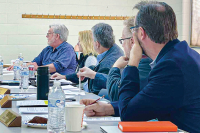A man’s got to work and fish
This past Sunday afternoon I decided to go for a walk along the Tuckasegee River west of Bryson City. If I had an objective, it was to see how far the waters of Fontana Lake have receded due to the recent dry spell. But my main purpose was, in reality, just to get out and look around. You never know what you might see.
I drove down the north side of the river along the paved portion of old Highway 288 to the boat ramp parking area. The road continues from this point as a one-lane dirt track until it quite literally vanishes in the waters of the lake.
In a nutshell, here’s how that came to be. In the 1930s and 1940s, Swain County gave up the majority of its private land to the federal government for the creation of the Great Smoky Mountains National Park, which was founded in 1934, and Fontana Lake, which was completed in 1945. The federal government’s unfulfilled pledge to replace Highway 288 with a new road crossing the Smokies created a controversy that continues to this day. That story is fully told in numerous sources; this is, after all, just a little essay about a Sunday afternoon walk, not a regional history lesson.
When the waters are backed up, the general area can rightly be called Fontana Lake; at other times, it is the Tuckasegee River. If you like pretty, breathtaking landscapes, this won’t be your cup of tea. For me, the setting is surreal in a pleasant manner.
For half a mile or so, only the bed of the river — a jumble of boulders and shallow pools — can be seen as it passes through an area of relatively steep ridges and cliffs. Between the dirt track and the river, on the left, is a 50-yard wide wasteland of logs, sand, and mud flats. The only large trees are black willow. It’s reputed that a single branch from a black willow can float for miles downstream before becoming embedded in mud, where a new tree is quickly established.
At one place in the midst of this wasteland, there is a slough bounded by a very narrow border of low-growing grasses. Detecting movement, I focused my binoculars on a green heron, which is about the size of a crow. It was walking about daintily, feeding perhaps on minnows trapped in the slough when the waters of the lake receded. Sometimes they do look green, but this green heron displayed a slate-gray back with iridescent purple sides. When its neck was suddenly extended, I spotted brown streaking, which indicated that it is a juvenile. Although I have seen countless adult green herons through the years, this was the first juvenile I have ever identified. It was of particular interest to me because, to my knowledge, the green heron is the only wading bird that breeds in the Blue Ridge
The dirt track borders, on the right, a steep embankment composed of rotted slate, shale, and sandstone. Just beyond the parking area are two large buttonwood shrubs situated at the base of the embankment. These uncommon shrubs mainly grow by ponds, lakes, and rivers. The perfectly round white flower heads of up to two inches in diameter are composed of many small flowers. Each flower displays extended anthers, which give the whole a fuzzy or prickly appearance. This was the first time in perhaps a decade I had encountered buttonbush in the wild.
Around the first bend, the track crosses over Lands Creek on a cement bridge that is underwater when the lake level is high. Lands Creek heads up below Noland Divide in the national park and flows out of the park for a while through private properties before entering the park again and finally emptying into what is either the Tuckasegee River or Fontana Lake. In this instance, it was the latter for the water was backed up to the very mouth of the creek. Beyond was the flat blue-green surface of water, in which was reflected the sky and the ridges.
A black snake crossed the track in front of me, moving like a dark ribbon over the sand. It crawled into a hollow stump and disappeared. I wanted to see the snake again but couldn’t get it to come out of its hiding place. Maybe it lived there.
A red pickup truck with Kentucky license plates was parked just beyond the bridge. Its owner was sitting on a log beside the lake with a camouflage-style baseball cap pulled down over his eyes. He looked to be about my age. Two bait-casting rods were propped up beside him on forked sticks.
I walked down the embankment and coughed so as to let him know I was there.
“Howdy,” I said. “You don’t have fish in Kentucky?”
“Oh, we got plenty of fish in Kentucky up near the West Virginia line where I live,” he replied with a smile. “But I’m not in Kentucky now and a man has got to fish.”
“What have you caught?” I asked.
“Nothing,” he replied. “But that don’t matter.”
“I just saw a black snake crawl in that stump up there,” I said.
“Yes,” he replied. “I saw it come out of the water.”
“Black snakes don’t swim,” I said.
“That one does,” he replied.
“How long have you been down here in North Carolina?” I asked.
“About a year and a half,” he replied. “I wish I was back home.”
“Then why’d you leave?” I asked.
“Work,” he replied. “A man has got to work.”
I wished him luck and walked on down around the next bend to where the dirt track ended. I could still see it for about 10 yards or so as it slanted down under the water and finally disappeared.
George Ellison wrote the biographical introductions for the reissues of two Appalachian classics: Horace Kephart’s Our Southern Highlanders and James Mooney’s History, Myths, and Sacred Formulas of the Cherokees. In June 2005, a selection of his Back Then columns was published by The History Press in Charleston as Mountain Passages: Natural and Cultural History of Western North Carolina and the Great Smoky Mountains. Readers can contact him at P.O. Box 1262, Bryson City, N.C., 28713, or at This email address is being protected from spambots. You need JavaScript enabled to view it..





